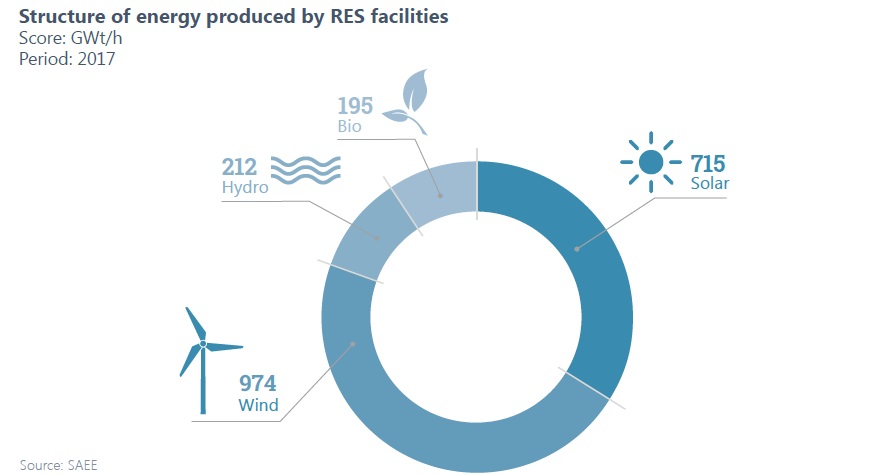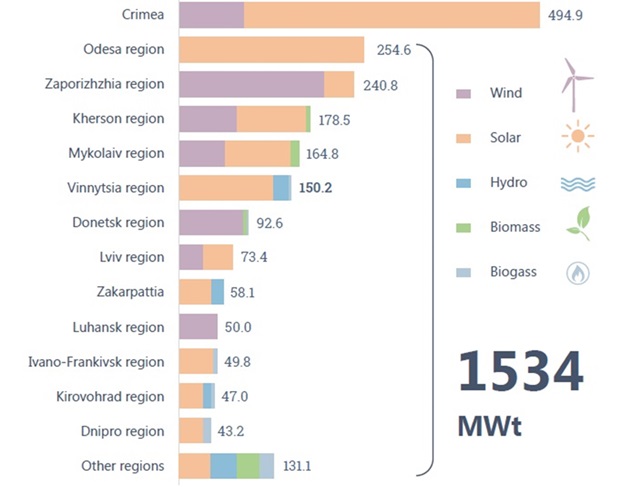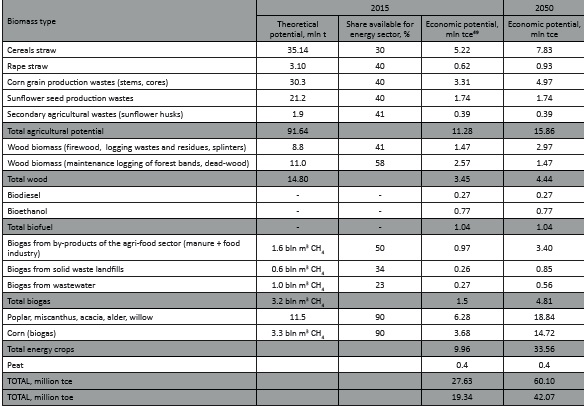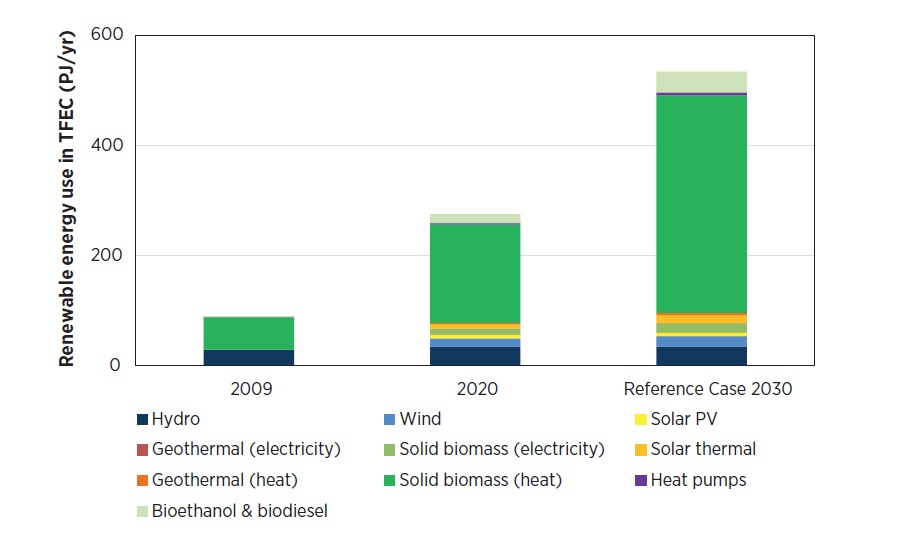A lively global debate continues in maintaining a balance between fossil fuels and nuclear energy, on the one hand, and renewable sources such as hydropower, solar, wind, geothermal and biomass, on the other. Being one of the largest energy markets in Europe and the largest consumer, Ukraine plays an important role in this debate.
If the renewable energy sector (RES) in the country continues to grow, it will strengthen energy security, market integration and decarbonization. International institutions, including the European Bank for Reconstruction and Development, have already demonstrated their confidence in the progress of the Ukrainian renewable energy sector.
What is the state of the industry for today? Is the Ukraine’s transition to renewable energy supported at the state level? What is the potential of Ukraine, and will we witness a complete transition to alternative energy?
The current state of the industry
Despite the fact that Ukraine is a newcomer to the renewable energy market, the growth rate in this sector is impressive. A recent review by the National Commission for State Regulation of Energy and Utilities showed that only during the second quarter of 2019 Ukraine launched wind power plants (wind farms) with a total capacity of 71 MW, solar (wind power plants) – 568.3 MW and biogas installations – 16 MW.
For comparison: in 2017, according to the State Agency for Energy Efficiency and Energy Saving of Ukraine, 87 new renewable energy facilities with a total capacity of 257 MW were commissioned, of which:
- 64 solar power facilities with a total capacity of 211 MW;
- 3 wind power facilities with a total capacity of 27.4 MW;
- 9 biomass power plants with a capacity of 14 MW;
- 3 small hydropower facilities with a total capacity of 4.6 MW.
In 2017, the total amount of energy produced by RES, according to the State Agency, amounted to 2096 GWh. Information on the share of each energy source in the total structure of the volume of electricity produced by renewable energy objects can be seen on Fig. 1.

What kind of renewable energy source prevails in a particular region can be seen on Fig. 2.

Over the last four years, about 1.5 billion euros have been invested in new renewable energy projects in Ukraine. Among all investment projects in the field of renewable energy, there is a unique opportunity to build a 1.2 GW solar power station in the Chernobyl exclusion zone (Fig. 3).
After the disaster at the station in 1986, the vast territory near the reactor became uninhabitable for hundreds of years. However, in 2016, French engineers were able to localize the radiation source by sliding an insulated arched structure onto the reactor building. There are a number of advantages to building an SES at this location:
- the acquisition of 2500 hectares of land in the 10-kilometer zone of the Chernobyl nuclear power plant in close proximity to roads and power lines can be carried out at a special rental price;
- The total area available for first priority solar power plants is 2500 hec., which corresponds to 1.2 GW of power; the project has flexible scaling due to the availability of easily acquired land;
- 1.2 GW can be divided into four stages, which will require the construction of new substations, including investment in infrastructure and land clearing;
- most of the infrastructure is in good working condition;
- network and connection, including transformer substation, open switchgears and high-voltage power lines, are available at close distances;
- Up to 1,500 GWh of annual energy production is expected;
- A preliminary feasibility study developed by Tractebel France and funded by the French Ministry of Economy and Finance confirms the financial and technical sustainability of the project.

State support and regulation of renewable energy sources
After the adoption of the Law of Ukraine “On the Electricity Market” in 2017, the renewable energy sector is developing rapidly. To stimulate the use of renewable energy, the government has introduced “green” tariffs that are compatible with EU preferential tariffs:
- a safe “green” tariff was provided until 2030 and was determined by the Law on Electricity;
- tariffs were set in euros – zero currency risk in hryvnia;
- the law guarantees the purchase of 100% of the energy produced from renewable energy sources by the wholesale operator;
- the law determines that the bonus for the use of Ukrainian equipment is provided at the level of 5-10% in addition to the existing introductory rate;
- an agreement on the purchase of electricity significantly protects the rights of investors and creditors;
- The National Energy Regulatory Commission is responsible for setting preferential tariffs, licensing RES, providing and distributing financial support to eligible parties.
Below is a comparative table of tariffs in Ukraine and other European countries (Fig. 4).

According to IRENA, the number of countries that have introduced a renewable energy auction system has grown to 67 in 2017 from 6 in 2005, and this number is still growing.
The auction is designed to prevent a monopoly on the Ukrainian renewable energy market. This is a transparent competition held through the ProZorro electronic trading system twice a year, in autumn and spring. According to him, participation in tenders will be mandatory from 2020 for solar energy projects with a capacity of more than 1 MW and wind power plants with a capacity of more than 5 MW. According to the terms of the competition, the one who offers the lowest price will be able to sell “clean” electricity to the state. By the end of this year, the first pilot auction is due to take place. The company that won the tender at the auction signs a contract and guarantees government support for 20 years.
The law provides that those who sign contracts in 2019 will be able to actually complete the construction of their blocks and facilities, providing current tariffs for solar projects for two years and for wind projects – for three.
The potential of renewable energy in the country
Ukraine is the largest country in Europe, there are more than 290 sunny days a year. The country is also uniquely fertile: agricultural land occupies 70% of the territory, that is, the bioenergy potential is obvious.
Ukraine can move to a 91% share of renewable energy by 2050, according to the report of the National Academy of Sciences and the Heinrich Belle Foundation “Transition of Ukraine to Renewable Energy by 2050”. The transition is expected to be both economically and technologically feasible.
According to the report, a complete transition is possible with:
- relevant targeted policies;
- refusal to build new nuclear units;
- severe control of emissions of thermal power plants;
- supporting measures to increase energy conservation and energy efficiency.
The main sources of energy will be wind, sun and biomass. It is estimated that energy production from the wind will be 45%, the sun – 36%, and biomass and waste – up to 73%.
In accordance with the calculations of the Ukrainian Wind Energy Association, the potential of the Ukrainian wind farm is 16 GW. The report of the National Academy of Sciences and the Heinrich Belle Foundation simulated two transition scenarios – liberal and revolutionary. According to the optimistic scenario, the potential of the wind farm in 2030 will be 25 GW, and in 2050 – 60 GW (Table 1).

According to the State Energy Efficiency of Ukraine, theoretically, the potential of the sun in our country is 730 billion kWh per year, but technically possible – 34.2 kWh per year. It is predicted that 40–50% of private households will use solar panels on their roofs until 2050. This, in turn, will increase the demand for the use of solar collectors for heating water. Thus, private households will be provided with hot water by 70-100% in the summer and 15% in the winter. Again, the report of the National Academy of Sciences and the Heinrich Belle Foundation modeled liberal and revolutionary approaches to the transition to solar energy (Table 2).

According to the Bioenergy Association of Ukraine, the country’s potential is about 20 million tons of energy, and in 2050 – 42 million tons of energy (Table 3).

Ukraine has made significant progress in planning the future of its energy system and developing its renewable energy policy. A report by the International Renewable Energy Agency (IRENA) notes that by 2030, increased use of renewable energy should reduce the overall costs of the Ukrainian energy system. Figure 5 shows the forecasts for the use of renewable energy sources.

It is noteworthy that some Ukrainian cities have already publicly announced the full transition to renewable energy by 2050. Zhytomyr is the first city in Eastern Europe where a full transition to alternative forms of energy is planned. The city Mayor announced this in 2018. The city authorities and the international non-governmental environmental organization 350.org are collaborating on this project. The same memoranda of cooperation with 350.org were signed by Kamenetz-Podolsky and Chertkov.
Well, in the case of the introduction of a target policy for the development of renewable energy (and this is the main condition for the revolutionary scenario of the “energy transition” of Ukraine), it is quite realistic to increase the share of alternative energy in the country to 91% by 2050. At the same time, it is necessary to reduce the need for energy resources by 42% compared to the conservative scenario.
The simulation results of the revolutionary scenario indicate that Ukraine has sufficient renewable energy potential, which can provide full coverage of possible demand for energy resources and services, even if a high proportion of energy-intensive industry is maintained.
Avenston constantly contributes to the development of the solar energy industry in Ukraine through the installation of a large number of ground and rooftop solar power plants. Our services for the construction of solar power plants cover all stages of such projects, not limited to the installation of solar panels. In our company, customers can order the design of a solar PV power plant, buy solar panels and inverters, get professional advice on any issues in the field of solar energy and other renewable energy sources.